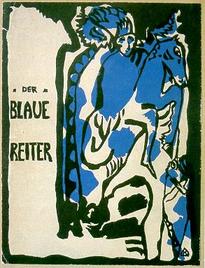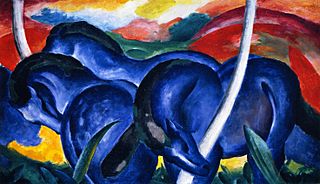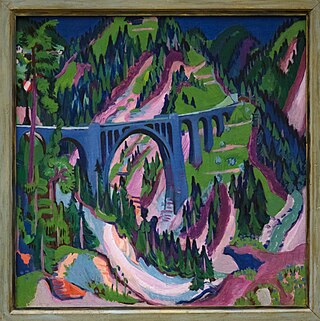
Franz Moritz Wilhelm Marc was a German painter and printmaker, one of the key figures of German Expressionism. He was a founding member of Der Blaue Reiter, a journal whose name later became synonymous with the circle of artists collaborating in it.

Der Blaue Reiter was a group of artists and a designation by Wassily Kandinsky and Franz Marc for their exhibition and publication activities, in which both artists acted as sole editors in the almanac of the same name. The editorial team organized two exhibitions in Munich in 1911 and 1912 to demonstrate their art-theoretical ideas based on the works of art exhibited. Traveling exhibitions in German and other European cities followed. The Blue Rider disbanded at the start of World War I in 1914.

Blue Horses is a 1911 painting by German painter and printmaker Franz Marc (1880–1916).

For other people called Ludwig Koch, see Ludwig Koch (disambiguation).

Bushkill Falls is a series of eight privately owned waterfalls, the tallest of which cascades over 100 feet (30 m), located in Lehman Township, Pennsylvania in the Pocono Mountains. Water of the Little Bush Kill and Pond Run Creek descends the mountain, toward the Delaware River, forming Bushkill Falls, Bridal Veil Falls, Bridesmaid Falls, Laurel Glen Falls, Pennell Falls, and three additional, unnamed falls.

Willi Baumeister was a German painter, scenic designer, art professor, and typographer. His work was part of the art competitions at the 1928 Summer Olympics and the 1932 Summer Olympics.
Robert Klümpen is a German painter.

Erika Abels d'Albert (1896–1975) was an Austrian painter and graphic artist.

Juno and Argus is a 1610 painting by Peter Paul Rubens, depicting Juno and Argus. It is now in the Wallraf-Richartz Museum in Cologne.

Oskar Begas was a German portrait and history painter.

The Sin is an 1893 painting by the German artist Franz Stuck. Stuck created twelve known versions of the painting. Some of these can be viewed at the Neue Pinakothek, in Munich, the National Gallery, in Berlin, the Galleria di arte Moderna, in Palermo, the Frye Art Museum, in Seattle, and at the Villa Stuck, in Munich, where it is enshrined in the artist's Künstleraltar. It depicts the nude Eve with a large serpent wrapped around her body. In the upper right corner is a bright field, while the rest of the surroundings are dark.

Carl Seibels was a German painter in the Biedermeier style.

The Foxes is a 1913 painting by German painter Franz Marc. It was held by the Museum Kunstpalast in Düsseldorf until returned to the heirs of Kurt Grawi in 2022, and sold at auction by them.

The Geologist is an glue paint on paper on canvas painting by the German painter Carl Spitzweg executed c. 1860. It belongs to the collection of the Von der Heydt Museum in Wuppertal, to which it was bequeathed in 1913. Spitzweg's style of painting belongs to the late Romantic period.

Female Half-Length Nude with Hat is an oil-on-canvas painting by German artist Ernst Ludwig Kirchner, executed in 1911. It his held at the Museum Ludwig in Cologne.

Adolf Erbslöh was a German Expressionist painter; one of the founders of the Neue Künstlervereinigung München.
Ottilie Reylaender was a German painter. She was one of the pioneers of modern art in Germany.

The Bridge near Wiesen, also known as The Bridge at Wiesen, is an oil-on-canvas painting by the German painter Ernst Ludwig Kirchner, from 1926. It depicts the Wiesen Viaduct, south of Davos, in Switzerland. It is signed on the bottom right of the center and is dated '26' on the back. The painting is held at the Kirchner Museum Davos.
















